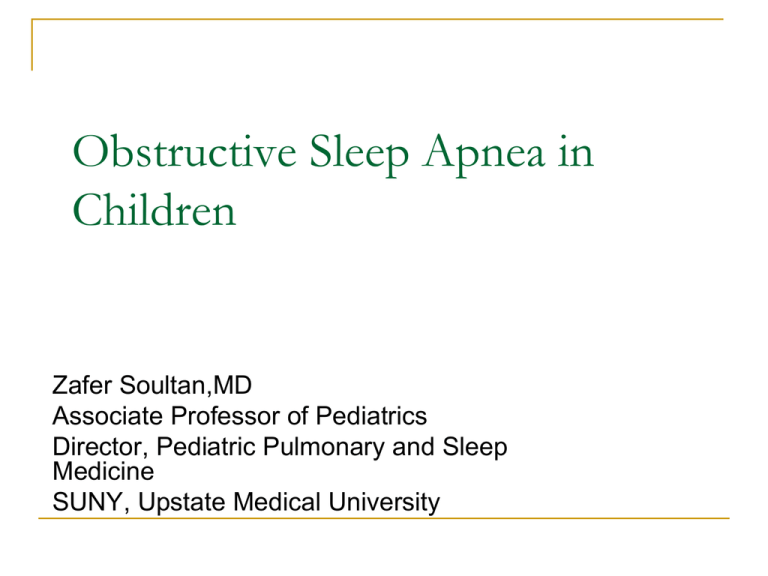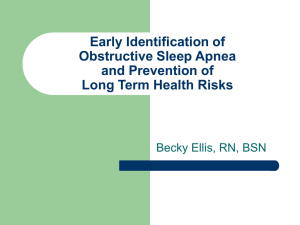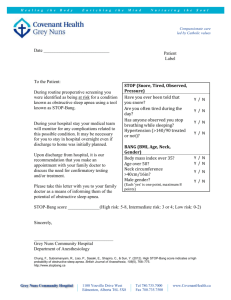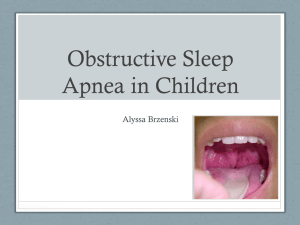Obstructive Sleep Apnea in Children
advertisement

Obstructive Sleep Apnea in Children Zafer Soultan,MD Associate Professor of Pediatrics Director, Pediatric Pulmonary and Sleep Medicine SUNY, Upstate Medical University Pediatric Obstructive Sleep Apnea - 10 +1 Weak muscles Cross-Section of Oropharynx Nasal obstruction Micro- or retrognathia Tonsillar hypertrophy Large tongue Pathophysiology of OSA Structural factors • Adenotonsillar hypertrophy • Craniofacial abnormality • Obesity Neuromotor tone • Cerebral palsy • Genetic diseases OSA Other factors • Genetic • Hormonal •? Risk Factors for Residual Obstructive Sleep Apnea After Adenotonsillectomy in Children Imanguli M; Laryngoscope 2016 Sleep Disordered Breathing Spectrum of conditions determined by relative amount of upper airway obstruction: (CIRCLES DISPLAY INCREASING UPPER AIRWAY OBSTRUCTION) o PS - Primary snoring: NOISY BREATHING o UARS - Upper airway resistance syndrome: NOISY BREATHING + DISTURBED SLEEP o OH - Obstructive hypoventilation: NOISY BREATHING ± DISTURBED SLEEP + CO2 and/or SaO2 o OSA - Obstructive sleep apnea: NOISY BREATHING ± DISTURBED SLEEP + CO2 and/or SaO2 + ABSENCE OF AIRFLOW OSA Epidemiology • • • • Habitual snoring 1.5-28% OSA – 1% to 5% M:F ratio approximately equal Prevalence is higher among African Americans, obese, AT hypertrophy, craniofacial anomalies Symptoms of OSA Frequent snoring (≥3 nights/wk) Labored breathing Gasps/snorting noises Apnea Enuresis (especially secondary) Sleeping in a seated position or with the neck hyperextended Cyanosis Headaches on awakening Daytime sleepiness Attention-deficit/hyperactivity disorder Learning problems Signs of OSA Underweight or overweight Tonsillar hypertrophy Adenoidal facies Micrognathia/retrognathia High-arched palate Failure to thrive Hypertension Sequelae Neuropsychological and Cognitive Problems Deficits in: Learning, memory, and visuospatial skills Language, verbal fluency, and phonological skills Concept formation, analytic thinking, and verbal and nonverbal comprehension School performance and mathematical abilities Executive functions; mental flexibility, impulse control and working memory There is correlation between different polysomnographic factors and cognitive outcomes. Behavioral abnormalities Hyperactivity; in younger kids ADHD Hypersomnolence Somatization Depression Atypicality Aggression, and abnormal social behaviors Improvement after treatment Gozal, D. Pediatrics 1998;102:616-620 Copyright ©1998 American Academy of Pediatrics Neurocognitive deficits were found at baseline in SDB children compared to controls; 10 point IQ difference (P<.001) and similar deficits in language and executive function. Adenotonsillectomy improved respiratory parameters and snoring frequency at 6 months post surgery, neurocognitive performance did not improve relative to controls. Kohler MJ, PLoS ONE. 2009;4(10):e7343 Phonologic processes and verbal fluency did not improve to normal. Montgomery-Downs Eur Respir J. 2005;25(2): 336–342. Lundeborg I, Clin Linguist Phon. 2009;23(10):751–761 Conclusions by the experts The majority of these studies suggest that in developing children who are dependent on executive function, cognition, and behavioral skills important for daily function and school performance, treatment of childhood SDB has benefits. Cardiovascular dysfunction Subclinical left sided and right sided and biventricular cardiac dysfunction Correlation between the presence and severity of OSA and elevated systolic and diastolic BP Effect on growth Girls Boys Marcus et al. J Pediatr 1994 Soultan, Z. Arch Pediatr Adolesc Med. 1999;153:33-37. Soultan, z. Arch Pediatr Adolesc Med. 1999;153:33-37. Inflammation Gozal L, J Clin Sleep Med. Author manuscript; available in PMC 2007 Apr 4. Inflammation Increased glucocorticoid and leukotriene receptors in adenotonsillar tissue from children who had OSAS compared with tissue from children who experienced chronic throat infections. Khalyfa A et al, Goldbart AD et al Diagnosis; just ask and verify Pediatric Sleep Questionnaire Patient Name: ____________________________________________________________ Date of Birth: ____________________________________________________________ Yes No While sleeping does your child… Snore more than half the time? Always snore? Snore loudly? Have “heavy” or loud breathing? Have trouble breathing or struggle to breathe? Have you ever… Seen your child stop breathing during the night? Does your child…. Tend to breathe through the mouth during the day? Have a dry mouth on waking up in the morning? Occasionally wet the bed? Wake up feeling un-refreshed in the morning? Have a problem with sleepiness during the day? Has a teacher or other supervisor commented that your child appears sleepy during the day? Is it hard to wake your child up in the morning? Does your child wake up with headaches in the morning? Did your child stop growing at a normal rate at any time since birth? Is your child overweight? This child often… Does not seem to listen when spoken to directly Has difficulty organizing tasks Is easily distracted by extraneous stimuli Fidgets with hands or feet or squirms in seat Is “on the go” or often acts as if “driven by a motor” Interrupts or intrudes on others (e.g. butts into conversations or games) Sensitivity 78-85 % Specificity 72-87% Total Number of “Yes” Responses _____________ If eight or more statements are answered “yes”, consider referring for sleep evaluation CHERVINE ET AL, PEDIATRIC SLEEP QUESTIONNAIRE: VALIDITY AND RELIABILITY OF SCALES FOR SLEEP DISORDERED BREATHING, SNORING, SLEEPINESS, AND BEHAVIORAL PROBLEMS, SLEEP MEDICINE 2000;1:21-32 Don’t Know Diagnosis Nocturnal oximetry Sensitivity 67%, and specificity 60% for moderate OSA AHI > 5. Kirk et al. Good correlation with PSG, but 80% of the 223 children had normal, inconclusive, or technically unsatisfactory oximetry. Brouillette et al Home sleep study; abbreviated form. Promising for school-aged children and for AHI >5 Pediatric Polysomnography EEG EOG Nasal EtCO2 Nasal Oral Airflow Chin EMG (2) Microphone Sao2 EKG Tech Observer Video Camera Respiratory Effort Documents arousals, parasomnias, abnormal sleeping position, and attends to any technical problem Leg EMG (2) Record behavior Courtesy of Dr. Carol Rosen Obstructive Sleep Apnea OBSTRUCTIVE APNEA OBSTRUCTIVE APNEA HYPOXEMIA FOLLOWING APNEIC EPISODE Obstructive Hypoventilation PARADOXICAL RIB-CAGE MOTION HYPERCAPNIA Pediatric Polysomnography Role of Polysomnography Differentiate OSA from primary snoring Define severity of OSAS Differential diagnosis Evaluate success of treatment Treatments: Adenotonsilletcomy, Partial tonsillectomy Pain and poor oral intake Bleeding, infection, anesthetic complications, respiratory decompensation, velopharyngeal incompetence, subglottic stenosis, obesity, and, rarely, death. In-patient observation: age <3 years, severe OSAS, presence of cardiac complications, failure to thrive, obesity, and presence of upper respiratory tract infection (URI). Does it work? Persistence of OSA after AT OSA (AHI >1) persistence 19%-73%, AHI ≥5/hour 13%-29%. Obesity: 51% AHI ≥5/hour; OR of persistent OSAS in 3.21 to 4.7. Severe OSA Very young and older children > 7 years independent of obesity Coexisting asthma, and family history Likely in children with craniofacial anomalies, Down syndrome, and neuromuscular disease Cure, improve with residual OSA after AT AHI: Pre AT 21.4 (2.3–147.5), post 1.5 (0–20.0) p <.001 The prevalence of residual OSA for AHI >1 criteria (72%), and AHI >2 was 38% Risk Factors for Residual Obstructive Sleep Apnea After Adenotonsillectomy in Children Imanguli M; Laryngoscope 2016 Conclusions by the experts AT is the most effective surgical therapy for pediatric patients, leading to an improvement in polysomnographic parameters in the vast majority of patients Significant proportion of patients are left with persistent OSAS after AT. 13-29% in low-risk population for AHI ≥5/hour 73% when including obese children and adolescents and a conservative AHI ≥1/hour. Children at highest risk of persistent OSAS are those who are obese and those with a high preoperative AHI, especially those with an AHI ≥20/hour, as well as children >7 years of age. Positive Airway Pressure Positive airway pressure Indications: persistent OSAS after AT, usually in obesity or craniofacial anomalies, and when surgery is contraindicated Effective in resolving symptoms and polysomnographic abnormalities Adherence? Special Considerations for CPAP in Children Need wide variety of mask sizes and styles to fit children Compliance may be enhanced by behavioral techniques Empowerment Positive reinforcement Desensitization Role modeling Medications Intranasal steroids may be considered for treatment of mild OSA; AHI <5/hour Sleep Med. 2007 Mar;8(2):128-34. Epub 2007 Jan 18. Rapid maxillary expansion in children with obstructive sleep apnea syndrome: 12-month follow-up. Villa et all The Childhood Adenotonsillectomy Trial (CHAT) Conclusions by the CHAT As compared with a strategy of watchful waiting, surgical treatment for the obstructive sleep apnea syndrome in school-age children did not significantly improve attention or executive function as measured by neuropsychological testing but did reduce symptoms and improve secondary outcomes of behavior, quality of life, and polysomnographic findings, thus providing evidence of beneficial effects of early adenotonsillectomy. (Funded by the National Institutes of Health; CHAT ClinicalTrials.gov number, NCT00560859.) Nothing is a medicine too (normalization of polysomnographic findings in 46% (79% after AT), but only for certain patients! “Normalization of polysomnographic findings in a large number of children in the watchful-waiting group and an absence of significant cognitive decline in this group indicate that medical management and reassessment after a period of observation may be a valid therapeutic option” Pediatrics. 1977 Jun;59(6):865-71. Hypoventilation during sleep in children who have lymphoid airway obstruction treated by nasopharyngeal tube and T and A. Kravath RE, Pollak CP, Borowiecki B. Abstract Three children with sleep apnea, alveolar hypoventilation, apparent mental retardation, and poor growth associated with chronically enlarged tonsils and adenoids were treated with the use of a nasopharyngeal tube followed by tonsillectomy and adenoidectomy. The effectiveness of this therapy was documented by polygraphic recording of sleep stages and respirations, and by correlation with serial arterial blood gases and pH. The nasopharyngeal tube was well tolerated, easy to use, and effective in diagnosis and treatment. We suggest that its use be further evaluated in patients with obstructive apnea. PMID: 865938 [PubMed - indexed for MEDLINE] Downloaded From: http://anesthesiology.pubs.asahq.org/pdfaccess.ashx?url=/data/Journals/JASA/931422/ on 04/09/2016 Kravath’ method We end with the AAP recommendations Inquire about snoring, and if positive do thorough evaluation. Polysomnogram (PSG), or referral to a sleep specialist or otolaryngologist If PSG is not available; nocturnal video recording, nocturnal oximetry, daytime nap PSG, or ambulatory PSG. Adenotonsillectomy (AT) Monitor high-risk patients after AT Reassess all patients with OSAS for persisting signs and symptoms after therapy Reevaluate high-risk patients for persistent OSAS after AT CPAP Weight loss AAP recommendations cont. Topical intranasal corticosteroids for children with mild OSAS in whom adenotonsillectomy is contraindicated or for children with mild post-operative OSAS Not AAP recommendation, do nothing? Conclusion We should not overlook OSA, because it does have serious consequences Early diagnosis and treatment of may improve a child’s long-term cognitive and social potential and school performance. The source and useful resource Diagnosis and Management of Childhood Obstructive Sleep Apnea Syndrome Carole L. Marcus, Lee Jay Brooks, Kari A. Draper, David Gozal, Ann Carol Halbower, Jacqueline Jones, Michael S. Schechter, Stephen Howard Sheldon, Karen Spruyt, Sally Davidson Ward, Christopher Lehmann and Richard N. Shiffman Pediatrics 2012;130;576; originally published online August 27, 2012; DOI: 10.1542/peds.2012-1671; The online version of this article, along with updated information and services, is located on the World Wide Web at: http://pediatrics.aappublications.org/content/130/3/576.full.html



